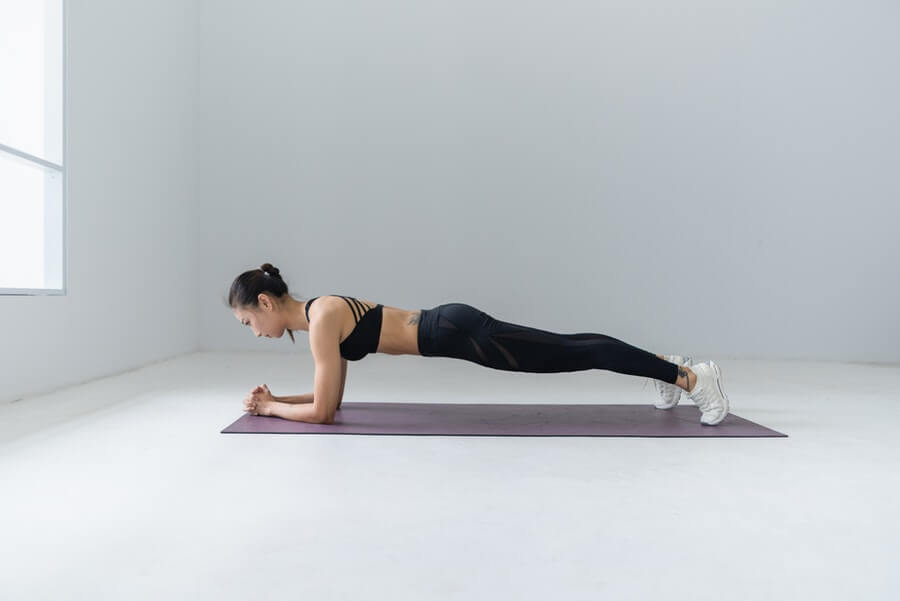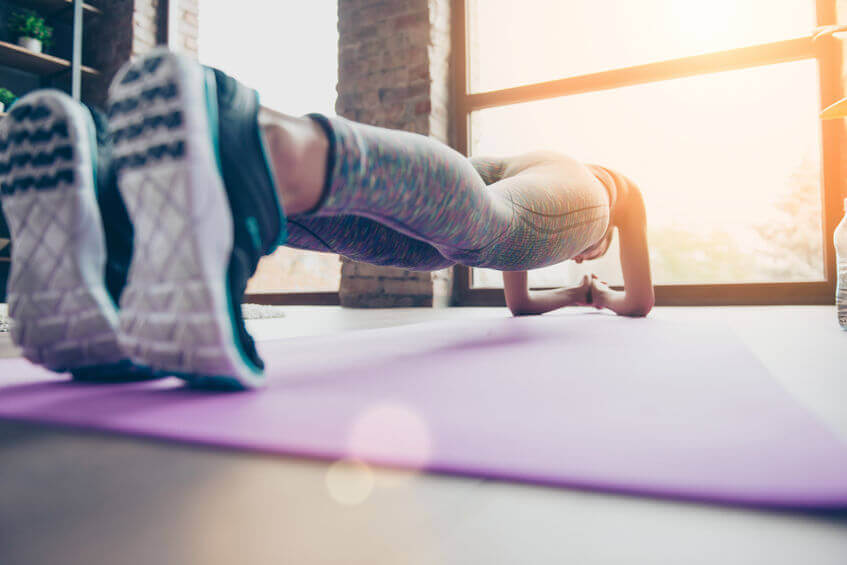Why You Should be Doing Isometric Exercises & TOP 6 Exercises for Quick Results
Ever done a plank? Ever held a squat?
You were doing an isometric exercise without even realizing it!
Isometrics have been around for a while, but recently they’ve experienced a surge in popularity as more people have realized the benefits.
Read on to learn all about what Isometrics are, their benefits, and how to include them in your home workout.
Contents
- Firstly, What is Isometric Exercise?
- What are the Benefits of Isometric Exercises?
- 1. Build Strength without Bulk
- 2. Build Strength in a Few Minutes per Day
- 3. No Equipment Required
- 4. Maintain Strength
- 5. Strengthen Core and Stabilizing Muscles
- 6. Recover From Injury
- 7. Lower Blood Pressure
- 8. Low Risk of Injury
- 9. Burn Calories
- 10. Increase Bone Density
- 11. Reduce Age Related Muscle Loss
- 12. Suitable for Arthritis Sufferers or Those With Mobility Issues
- 13. Increase Endurance
- 14. Move Past a Plateau
- So, What are the Best Isometric Exercises?
- FAQs
Firstly, What is Isometric Exercise?
Isometric exercise is effectively static strength training, meaning you hold a position for long enough to put a stress on a particular group of muscles without actually moving them.
There are three kinds of muscle contractions that can occur. These are concentric, eccentric and isometric.
When your muscles contract while tensing, for example when your abs shorten in a crunchy, you are experiencing a concentric contraction.
The opposite of this is an eccentric contraction which is when your muscles lengthen while tensing – think lying down slowly out of your sit up.
Last but not least, isometric contractions are when your muscles are tensed and working, but not actively shortening or lengthening.
This can occur at any point in a movement provided you stay still but keep your muscles tense.
The most commonly known isometric exercises are planks, holding a squat, or a wall sit.
But, any movement can put isometric stress on your muscles once you stop and hold the position.
Imagine stopping part way up and part way down in your chin up and holding the position for 5 seconds. Gnarly, right?
So other than being a hard workout for your muscles, let’s move on to the actual benefits of isometric exercises!
What are the Benefits of Isometric Exercises?
There are so many benefits to isometric exercises, you’ll be kicking yourself for not including them in your workouts sooner!
Or at least for not including them more!
1. Build Strength without Bulk
Isometric exercises build muscle strength without building muscle size. Not everyone wants to bulk up, but most of us want to be a little stronger.
Isometrics are excellent at increasing muscle strength, but the lack of movement means that you aren’t creating the micro-tears that force the muscles to grow.
This also makes for a quicker recovery!
2. Build Strength in a Few Minutes per Day
Isometrics are quick and efficient to perform. You could move through a few key isometric exercises in just 10 minutes and have activated almost every muscle group in your body, resulting in the perfect workout for people short on time.
3. No Equipment Required
You do of course have the option of using weights for your isometric exercises. But, many don’t require the use of extra equipment and only use your body weight.
This means isometrics are a free exercise that anyone can perform in their home!
But, I don’t blame you if you want to chuck some weights into the mix. If you think you will be on the lookout for some weights for other exercises as well as your new0found love of isometrics, check out our guide to the best adjustable dumbbells!
4. Maintain Strength
If you’re short on time but don’t want to lose the muscle strength you’ve already fought to gain, doing just a few minutes a day of isometrics can easily maintain your strength without having to go through all those reps.
5. Strengthen Core and Stabilizing Muscles
This is a big one. Isometric exercises could be the best way of strengthening core and stabilizing muscles.
You end up with better posture, resilience against injury, and a much stronger core than you would otherwise get from regular exercises.
6. Recover From Injury
Isometrics are particularly good at aiding in injury rehabilitation. The lack of movement means that you can strengthen targeted muscles while easily isolating and protecting the injury.
This means that supporting muscles are being strengthened so when the time comes, you won’t have as much work to do to get back to where you were!
7. Lower Blood Pressure
The Journal of the American Heart Foundation found that isometric exercises are also particularly good at lowering both systolic and diastolic blood pressure, as well as mean arterial pressure.
That’s got to be a win!
8. Low Risk of Injury
The lack of quick movements under stress while performing isometric exercises means that you have a decreased risk of experiencing an injury such as a strained muscle or ligament.
This makes isometrics a really safe way of exercising.
9. Burn Calories
Isometrics activate a wider range of muscles than regular resistance training which means you’ll burn calories and come closer to your weight loss goals.
Incorporating isometrics into your weekly workout routine along with your chosen form of cardio is a fail-safe way of keeping your weight loss journey moving in the right direction.
If you’re looking for some more inspiration, we have a guide to the best machines for weight loss which will also help!
10. Increase Bone Density
Isometric exercise is especially good at building bone density, reducing your risk of osteoporosis later in life.
11. Reduce Age Related Muscle Loss
Isometrics allow you to easily maintain the strength and muscle mass of your muscles and protect against the natural muscle wasting that occurs as you age.
12. Suitable for Arthritis Sufferers or Those With Mobility Issues
The stationary aspect of isometric exercise makes it ideal for people with arthritis, joint pain, or mobility issues.
Isometric exercises allow you build strength in a muscle group without putting stress on the associated joints, so you can still exercise without making your pain worse.
Isometrics in combination with some form of cardio is the perfect exercise solution for people with arthritis or mobility issues. Recumbent bikes are a perfect example of low impact cardio that is comfortable for people with painful joints. We have a list of the best recumbent bikes here if you’re interested.
13. Increase Endurance
If lifting weights is like sprinting, then holding those weights is like a marathon.
Isometrics is one of the best ways of increasing endurance in muscles which translates into better overall strength and fitness.
14. Move Past a Plateau
Isometric exercises are an excellent way of overcoming a plateau in your strength training.
If you’re trying to move towards lifting heavier weights but you’ve found yourself stuck at a certain weight, practicing isometric exercises at the point of the lift where you are weakest may just be the fix you’re looking for.
Research has shown that holding a lift at a certain point for a given amount of time doesn’t just improve muscle strength for that specific position, but up to 15 degrees either side of that position.
As you can see from this list, the advantages of isometric exercises are huge and varied. There is simply no reason to not include them in your workouts, starting right now!
So, What are the Best Isometric Exercises?
This depends on your goals. If you have a specific movement or muscle group that you want to target, then you’ll want to isolate a position within that movement to hold for 5 – 10 seconds before continuing the movement, or choose an isometric exercise specific to the muscle group you want to focus on.
In saying this, there are some isometrics that are just so awesome that everyone should be doing them! They don’t require any equipment and utilize a massive number of muscles, including plenty of core.
These 6 positions include all of the benefits of isometric exercises.
What are they?
Plank
Everyone knows the plank. If you don’t, there’s a video here describing the correct technique. Remember, keep you back straight and don’t let your hips sink!
Side Plank
A side plank is very similar to a regular plank except that, you guessed it, you’re on your side, with your body weight balanced on one bent arm. You can also make this harder by lifting one leg into the air.
Half Press Up
Act as if you’re doing a regular press up, but stop when your arms reach a 90 degree angle and hold for 30 seconds. Then, push back up. Hold for another 30 seconds and repeat.
Wall Sit
This position targets the quads but also your core. Stand against a wall with your legs hip width apart and lower yourself into a sitting position so that your knees are at a 90 degree angle, directly over your feet. Hold for 30 seconds to a minute and then stand to rest. Repeat.
Pause Squat
Similar to the wall sit but harder, the pause squat utilizes your back muscles as well as more stabilizing muscles in your legs. It’s also a great way of increasing hip flexibility.
You can essentially choose at which point in your squat you choose to pause. You might even choose to pause twice on the way down and twice on the way up for a real muscle-burning squat!
Just be sure you’re practicing correct form so you don’t put undue stress on your knees. Make sure each knee is tracking over the middle of your feet and not caving inwards.
Pause Lunges
Carry out a regular lunge, but when you get to the point where your front knee is 90 degrees and directly over your front foot, pause and hold, consciously activating the buttock of your back leg for best effect.
This is just the beginning! There are so many great isometric exercises that could make all the difference to your workout goals.
Be creative, and so long as you’re practicing good form, there is no limit to the number of positions you can hold.
FAQs
When would You use Isometric Exercises?
Isometric exercises can be incorporated into the workout routine you already have, or you can include short periods of isometrics throughout your day.
Say you do a squat and hold it for 20 seconds while you wait for the kettle to boil.
Isometrics are a great way of adding variety to your routine, helping to overcome plateaus.
Is Yoga an Isometric Exercise?
Yoga in itself is not an isometric exercise, but when yoga poses, or asanas, are held for a certain amount of time, then this is an isometric exercise.
How Long Should You Hold an Isometric Exercise?
This depends on your strength. You might start with holding a position for just a few seconds and build up to a minute.
How Often Should You do Isometric Exercises?
Can you do isometric every day? Isometrics are just like any other form of exercise in that they use your muscles, and muscles need time to recover before they can compensate for the stress you’ve placed on them, and increase in strength in order to adapt.
So, performing isometrics every day probably isn’t a good idea, unless you’re rotating muscle groups so you’re not stressing the same muscles every day. 3 – 5 times per week is probably the max you want to be doing.
Hopefully that answers all your questions and you feel well prepared and excited to start including isometrics in your home workouts!
Feel free to share any thoughts below or ask any further questions. And if you’re not already subscribed, be sure to sign up so you can get all the latest reviews direct to your inbox!



